Business Law: Analysis of Flavel v The State of South Australia Case
VerifiedAdded on 2023/06/12
|9
|2270
|428
Case Study
AI Summary
This case study provides an in-depth analysis of the Australian case FLAVEL v THE STATE OF SOUTH AUSTRALIA [2007] SASC 50, which concerns the tort of negligence. The case involves a student who sustained a severe spinal injury during a school-organized windsurfing activity. The plaintiff alleged that the Department of Education and Children’s Services, the defendant, breached its duty of care by failing to provide adequate instructions, training, safety equipment, and supervision. The court examined the elements of negligence—duty of care, breach of duty, and causation—based on principles established in Donoghue v Stevenson. While acknowledging the plaintiff's devastating injury, the court ultimately ruled in favor of the defendant, concluding that reasonable precautions were taken and that the defendant did not breach its duty of care. The analysis highlights the court's reasoning, emphasizing that the defendant's actions did not significantly alter the inherent risks of the activity and that the injury was not a direct result of negligence or inadequate supervision.
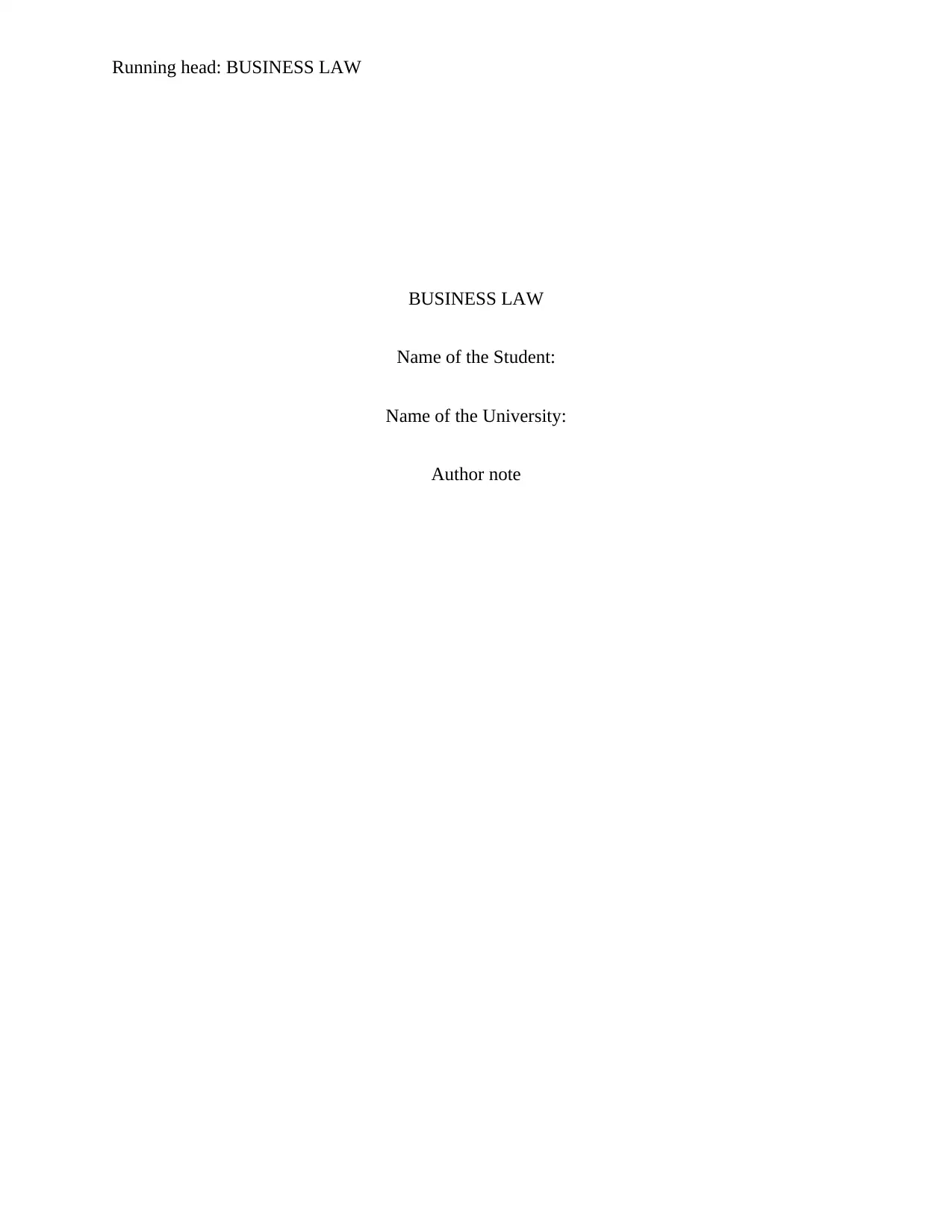
Running head: BUSINESS LAW
BUSINESS LAW
Name of the Student:
Name of the University:
Author note
BUSINESS LAW
Name of the Student:
Name of the University:
Author note
Paraphrase This Document
Need a fresh take? Get an instant paraphrase of this document with our AI Paraphraser
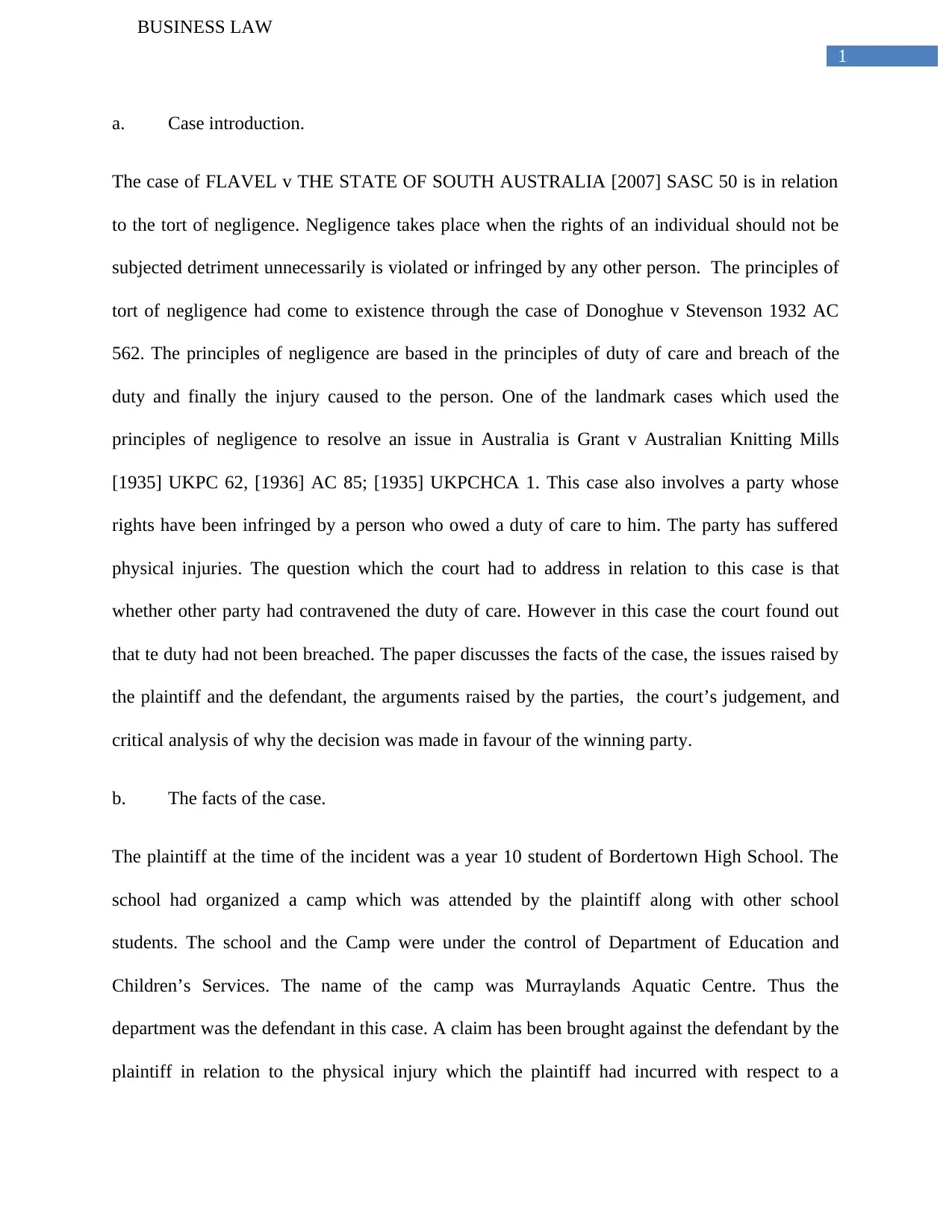
1
BUSINESS LAW
a. Case introduction.
The case of FLAVEL v THE STATE OF SOUTH AUSTRALIA [2007] SASC 50 is in relation
to the tort of negligence. Negligence takes place when the rights of an individual should not be
subjected detriment unnecessarily is violated or infringed by any other person. The principles of
tort of negligence had come to existence through the case of Donoghue v Stevenson 1932 AC
562. The principles of negligence are based in the principles of duty of care and breach of the
duty and finally the injury caused to the person. One of the landmark cases which used the
principles of negligence to resolve an issue in Australia is Grant v Australian Knitting Mills
[1935] UKPC 62, [1936] AC 85; [1935] UKPCHCA 1. This case also involves a party whose
rights have been infringed by a person who owed a duty of care to him. The party has suffered
physical injuries. The question which the court had to address in relation to this case is that
whether other party had contravened the duty of care. However in this case the court found out
that te duty had not been breached. The paper discusses the facts of the case, the issues raised by
the plaintiff and the defendant, the arguments raised by the parties, the court’s judgement, and
critical analysis of why the decision was made in favour of the winning party.
b. The facts of the case.
The plaintiff at the time of the incident was a year 10 student of Bordertown High School. The
school had organized a camp which was attended by the plaintiff along with other school
students. The school and the Camp were under the control of Department of Education and
Children’s Services. The name of the camp was Murraylands Aquatic Centre. Thus the
department was the defendant in this case. A claim has been brought against the defendant by the
plaintiff in relation to the physical injury which the plaintiff had incurred with respect to a
BUSINESS LAW
a. Case introduction.
The case of FLAVEL v THE STATE OF SOUTH AUSTRALIA [2007] SASC 50 is in relation
to the tort of negligence. Negligence takes place when the rights of an individual should not be
subjected detriment unnecessarily is violated or infringed by any other person. The principles of
tort of negligence had come to existence through the case of Donoghue v Stevenson 1932 AC
562. The principles of negligence are based in the principles of duty of care and breach of the
duty and finally the injury caused to the person. One of the landmark cases which used the
principles of negligence to resolve an issue in Australia is Grant v Australian Knitting Mills
[1935] UKPC 62, [1936] AC 85; [1935] UKPCHCA 1. This case also involves a party whose
rights have been infringed by a person who owed a duty of care to him. The party has suffered
physical injuries. The question which the court had to address in relation to this case is that
whether other party had contravened the duty of care. However in this case the court found out
that te duty had not been breached. The paper discusses the facts of the case, the issues raised by
the plaintiff and the defendant, the arguments raised by the parties, the court’s judgement, and
critical analysis of why the decision was made in favour of the winning party.
b. The facts of the case.
The plaintiff at the time of the incident was a year 10 student of Bordertown High School. The
school had organized a camp which was attended by the plaintiff along with other school
students. The school and the Camp were under the control of Department of Education and
Children’s Services. The name of the camp was Murraylands Aquatic Centre. Thus the
department was the defendant in this case. A claim has been brought against the defendant by the
plaintiff in relation to the physical injury which the plaintiff had incurred with respect to a
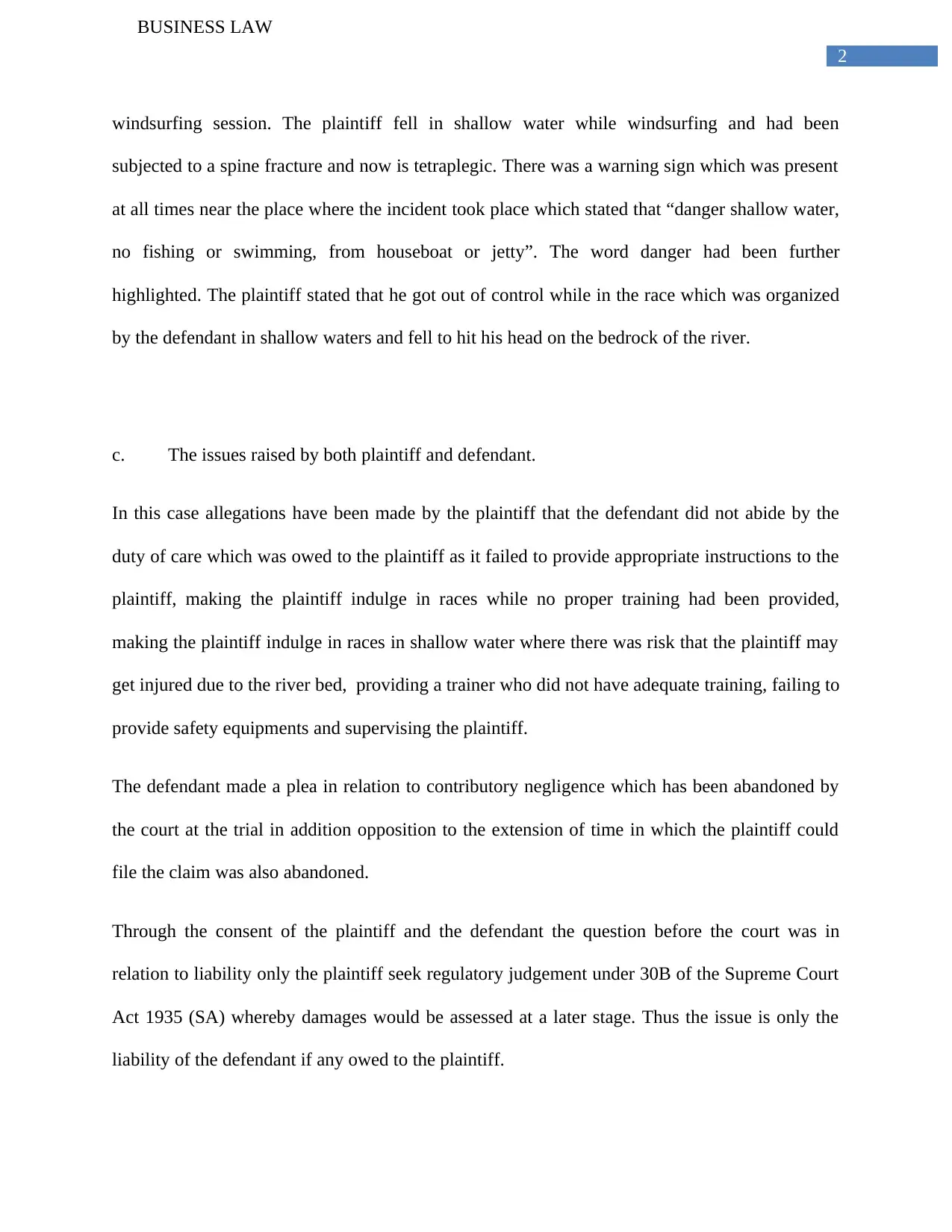
2
BUSINESS LAW
windsurfing session. The plaintiff fell in shallow water while windsurfing and had been
subjected to a spine fracture and now is tetraplegic. There was a warning sign which was present
at all times near the place where the incident took place which stated that “danger shallow water,
no fishing or swimming, from houseboat or jetty”. The word danger had been further
highlighted. The plaintiff stated that he got out of control while in the race which was organized
by the defendant in shallow waters and fell to hit his head on the bedrock of the river.
c. The issues raised by both plaintiff and defendant.
In this case allegations have been made by the plaintiff that the defendant did not abide by the
duty of care which was owed to the plaintiff as it failed to provide appropriate instructions to the
plaintiff, making the plaintiff indulge in races while no proper training had been provided,
making the plaintiff indulge in races in shallow water where there was risk that the plaintiff may
get injured due to the river bed, providing a trainer who did not have adequate training, failing to
provide safety equipments and supervising the plaintiff.
The defendant made a plea in relation to contributory negligence which has been abandoned by
the court at the trial in addition opposition to the extension of time in which the plaintiff could
file the claim was also abandoned.
Through the consent of the plaintiff and the defendant the question before the court was in
relation to liability only the plaintiff seek regulatory judgement under 30B of the Supreme Court
Act 1935 (SA) whereby damages would be assessed at a later stage. Thus the issue is only the
liability of the defendant if any owed to the plaintiff.
BUSINESS LAW
windsurfing session. The plaintiff fell in shallow water while windsurfing and had been
subjected to a spine fracture and now is tetraplegic. There was a warning sign which was present
at all times near the place where the incident took place which stated that “danger shallow water,
no fishing or swimming, from houseboat or jetty”. The word danger had been further
highlighted. The plaintiff stated that he got out of control while in the race which was organized
by the defendant in shallow waters and fell to hit his head on the bedrock of the river.
c. The issues raised by both plaintiff and defendant.
In this case allegations have been made by the plaintiff that the defendant did not abide by the
duty of care which was owed to the plaintiff as it failed to provide appropriate instructions to the
plaintiff, making the plaintiff indulge in races while no proper training had been provided,
making the plaintiff indulge in races in shallow water where there was risk that the plaintiff may
get injured due to the river bed, providing a trainer who did not have adequate training, failing to
provide safety equipments and supervising the plaintiff.
The defendant made a plea in relation to contributory negligence which has been abandoned by
the court at the trial in addition opposition to the extension of time in which the plaintiff could
file the claim was also abandoned.
Through the consent of the plaintiff and the defendant the question before the court was in
relation to liability only the plaintiff seek regulatory judgement under 30B of the Supreme Court
Act 1935 (SA) whereby damages would be assessed at a later stage. Thus the issue is only the
liability of the defendant if any owed to the plaintiff.
⊘ This is a preview!⊘
Do you want full access?
Subscribe today to unlock all pages.

Trusted by 1+ million students worldwide
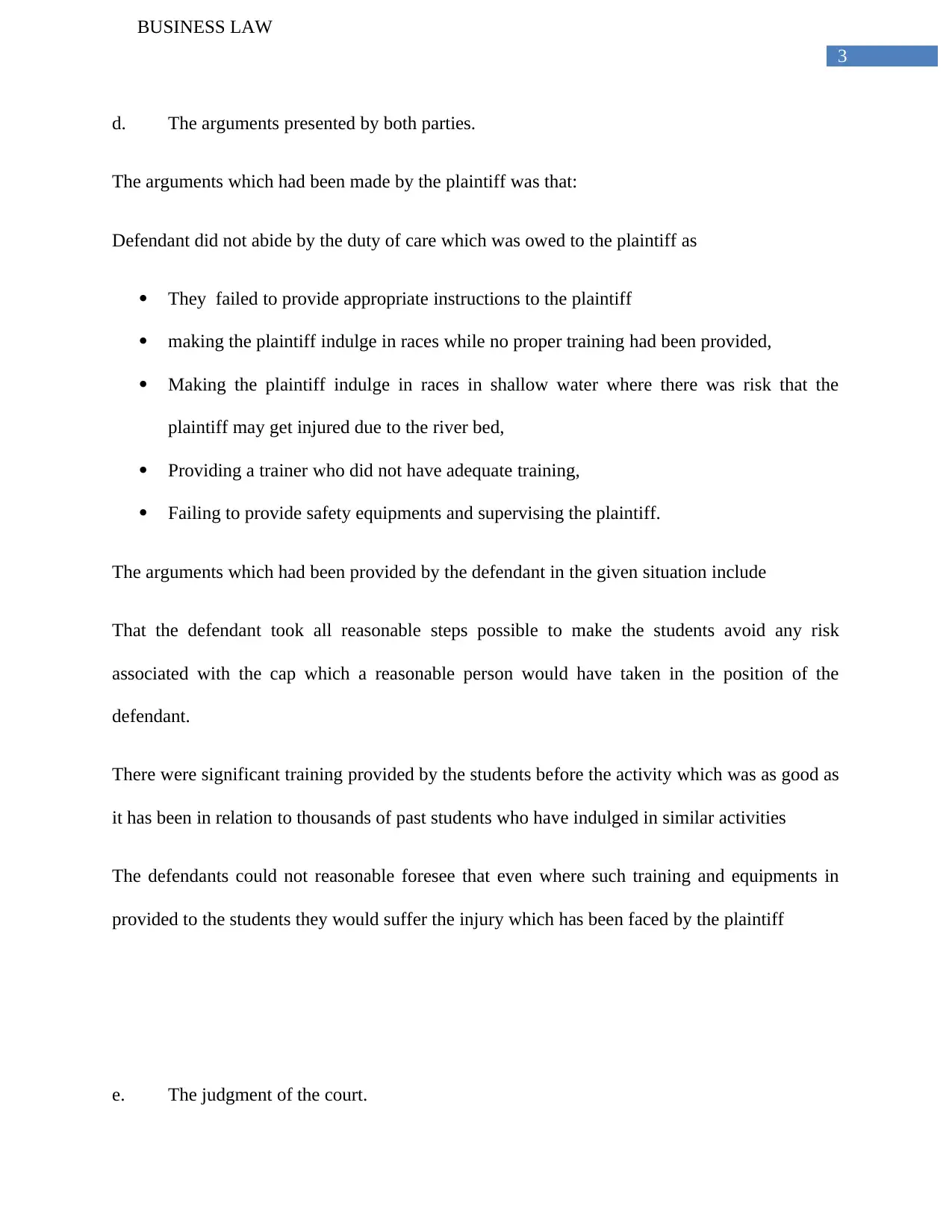
3
BUSINESS LAW
d. The arguments presented by both parties.
The arguments which had been made by the plaintiff was that:
Defendant did not abide by the duty of care which was owed to the plaintiff as
They failed to provide appropriate instructions to the plaintiff
making the plaintiff indulge in races while no proper training had been provided,
Making the plaintiff indulge in races in shallow water where there was risk that the
plaintiff may get injured due to the river bed,
Providing a trainer who did not have adequate training,
Failing to provide safety equipments and supervising the plaintiff.
The arguments which had been provided by the defendant in the given situation include
That the defendant took all reasonable steps possible to make the students avoid any risk
associated with the cap which a reasonable person would have taken in the position of the
defendant.
There were significant training provided by the students before the activity which was as good as
it has been in relation to thousands of past students who have indulged in similar activities
The defendants could not reasonable foresee that even where such training and equipments in
provided to the students they would suffer the injury which has been faced by the plaintiff
e. The judgment of the court.
BUSINESS LAW
d. The arguments presented by both parties.
The arguments which had been made by the plaintiff was that:
Defendant did not abide by the duty of care which was owed to the plaintiff as
They failed to provide appropriate instructions to the plaintiff
making the plaintiff indulge in races while no proper training had been provided,
Making the plaintiff indulge in races in shallow water where there was risk that the
plaintiff may get injured due to the river bed,
Providing a trainer who did not have adequate training,
Failing to provide safety equipments and supervising the plaintiff.
The arguments which had been provided by the defendant in the given situation include
That the defendant took all reasonable steps possible to make the students avoid any risk
associated with the cap which a reasonable person would have taken in the position of the
defendant.
There were significant training provided by the students before the activity which was as good as
it has been in relation to thousands of past students who have indulged in similar activities
The defendants could not reasonable foresee that even where such training and equipments in
provided to the students they would suffer the injury which has been faced by the plaintiff
e. The judgment of the court.
Paraphrase This Document
Need a fresh take? Get an instant paraphrase of this document with our AI Paraphraser
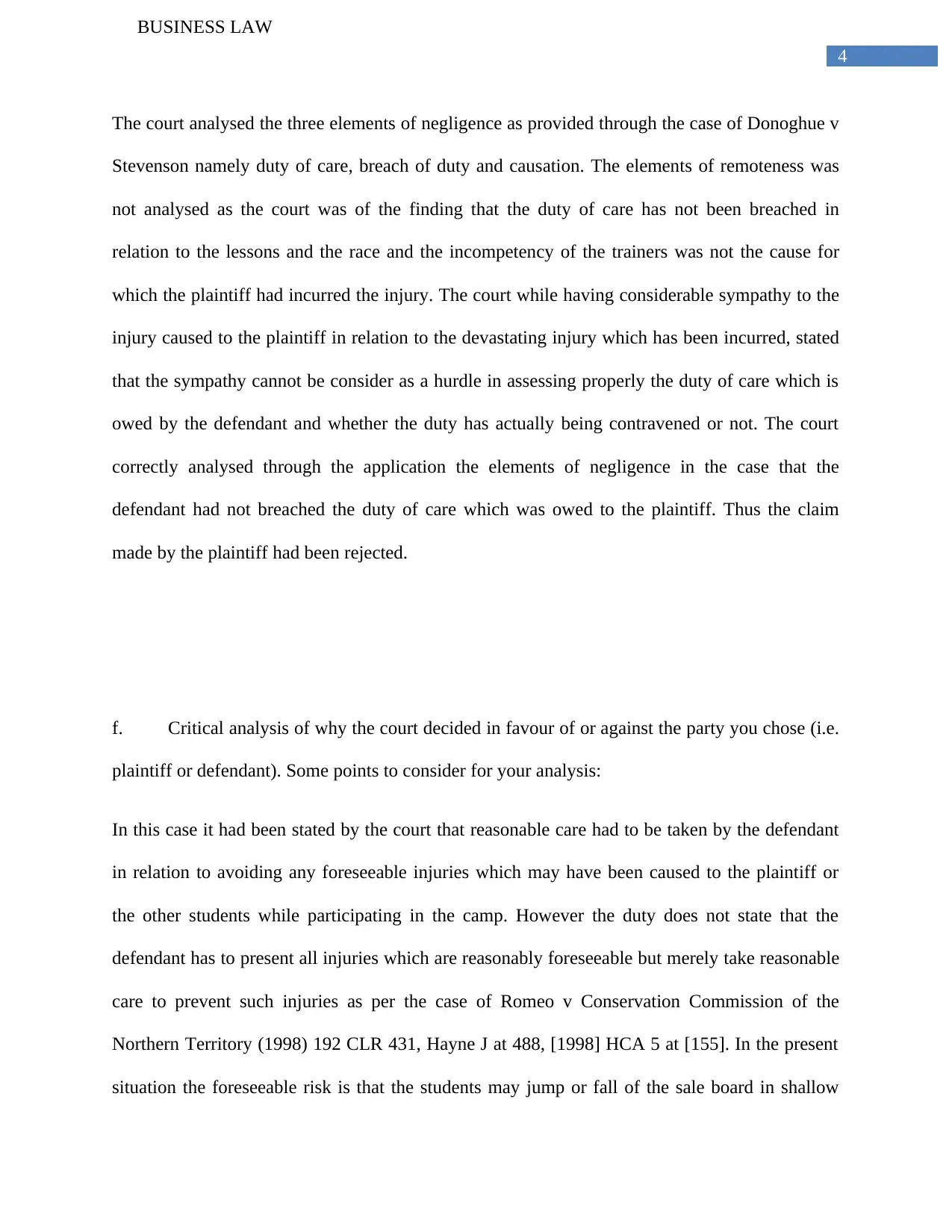
4
BUSINESS LAW
The court analysed the three elements of negligence as provided through the case of Donoghue v
Stevenson namely duty of care, breach of duty and causation. The elements of remoteness was
not analysed as the court was of the finding that the duty of care has not been breached in
relation to the lessons and the race and the incompetency of the trainers was not the cause for
which the plaintiff had incurred the injury. The court while having considerable sympathy to the
injury caused to the plaintiff in relation to the devastating injury which has been incurred, stated
that the sympathy cannot be consider as a hurdle in assessing properly the duty of care which is
owed by the defendant and whether the duty has actually being contravened or not. The court
correctly analysed through the application the elements of negligence in the case that the
defendant had not breached the duty of care which was owed to the plaintiff. Thus the claim
made by the plaintiff had been rejected.
f. Critical analysis of why the court decided in favour of or against the party you chose (i.e.
plaintiff or defendant). Some points to consider for your analysis:
In this case it had been stated by the court that reasonable care had to be taken by the defendant
in relation to avoiding any foreseeable injuries which may have been caused to the plaintiff or
the other students while participating in the camp. However the duty does not state that the
defendant has to present all injuries which are reasonably foreseeable but merely take reasonable
care to prevent such injuries as per the case of Romeo v Conservation Commission of the
Northern Territory (1998) 192 CLR 431, Hayne J at 488, [1998] HCA 5 at [155]. In the present
situation the foreseeable risk is that the students may jump or fall of the sale board in shallow
BUSINESS LAW
The court analysed the three elements of negligence as provided through the case of Donoghue v
Stevenson namely duty of care, breach of duty and causation. The elements of remoteness was
not analysed as the court was of the finding that the duty of care has not been breached in
relation to the lessons and the race and the incompetency of the trainers was not the cause for
which the plaintiff had incurred the injury. The court while having considerable sympathy to the
injury caused to the plaintiff in relation to the devastating injury which has been incurred, stated
that the sympathy cannot be consider as a hurdle in assessing properly the duty of care which is
owed by the defendant and whether the duty has actually being contravened or not. The court
correctly analysed through the application the elements of negligence in the case that the
defendant had not breached the duty of care which was owed to the plaintiff. Thus the claim
made by the plaintiff had been rejected.
f. Critical analysis of why the court decided in favour of or against the party you chose (i.e.
plaintiff or defendant). Some points to consider for your analysis:
In this case it had been stated by the court that reasonable care had to be taken by the defendant
in relation to avoiding any foreseeable injuries which may have been caused to the plaintiff or
the other students while participating in the camp. However the duty does not state that the
defendant has to present all injuries which are reasonably foreseeable but merely take reasonable
care to prevent such injuries as per the case of Romeo v Conservation Commission of the
Northern Territory (1998) 192 CLR 431, Hayne J at 488, [1998] HCA 5 at [155]. In the present
situation the foreseeable risk is that the students may jump or fall of the sale board in shallow
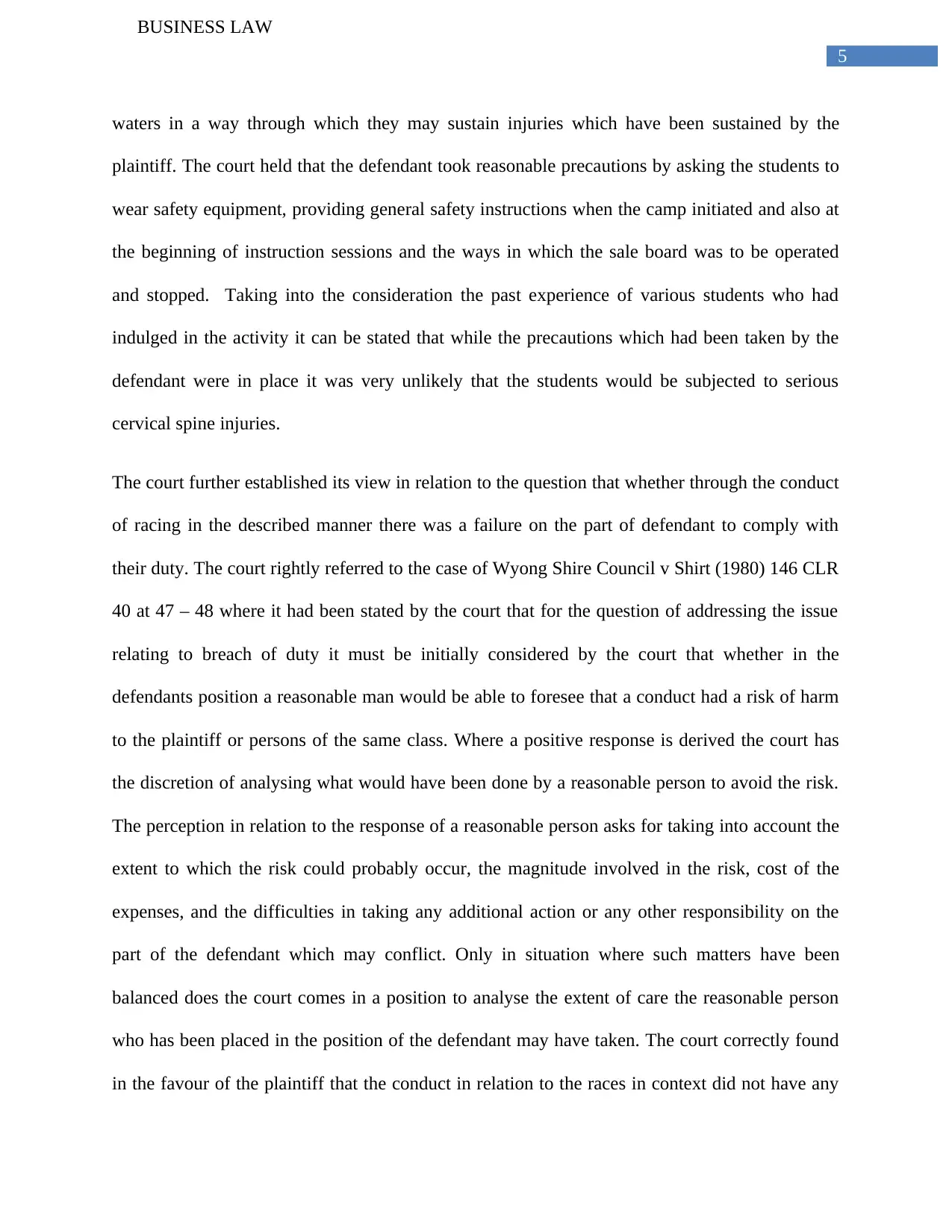
5
BUSINESS LAW
waters in a way through which they may sustain injuries which have been sustained by the
plaintiff. The court held that the defendant took reasonable precautions by asking the students to
wear safety equipment, providing general safety instructions when the camp initiated and also at
the beginning of instruction sessions and the ways in which the sale board was to be operated
and stopped. Taking into the consideration the past experience of various students who had
indulged in the activity it can be stated that while the precautions which had been taken by the
defendant were in place it was very unlikely that the students would be subjected to serious
cervical spine injuries.
The court further established its view in relation to the question that whether through the conduct
of racing in the described manner there was a failure on the part of defendant to comply with
their duty. The court rightly referred to the case of Wyong Shire Council v Shirt (1980) 146 CLR
40 at 47 – 48 where it had been stated by the court that for the question of addressing the issue
relating to breach of duty it must be initially considered by the court that whether in the
defendants position a reasonable man would be able to foresee that a conduct had a risk of harm
to the plaintiff or persons of the same class. Where a positive response is derived the court has
the discretion of analysing what would have been done by a reasonable person to avoid the risk.
The perception in relation to the response of a reasonable person asks for taking into account the
extent to which the risk could probably occur, the magnitude involved in the risk, cost of the
expenses, and the difficulties in taking any additional action or any other responsibility on the
part of the defendant which may conflict. Only in situation where such matters have been
balanced does the court comes in a position to analyse the extent of care the reasonable person
who has been placed in the position of the defendant may have taken. The court correctly found
in the favour of the plaintiff that the conduct in relation to the races in context did not have any
BUSINESS LAW
waters in a way through which they may sustain injuries which have been sustained by the
plaintiff. The court held that the defendant took reasonable precautions by asking the students to
wear safety equipment, providing general safety instructions when the camp initiated and also at
the beginning of instruction sessions and the ways in which the sale board was to be operated
and stopped. Taking into the consideration the past experience of various students who had
indulged in the activity it can be stated that while the precautions which had been taken by the
defendant were in place it was very unlikely that the students would be subjected to serious
cervical spine injuries.
The court further established its view in relation to the question that whether through the conduct
of racing in the described manner there was a failure on the part of defendant to comply with
their duty. The court rightly referred to the case of Wyong Shire Council v Shirt (1980) 146 CLR
40 at 47 – 48 where it had been stated by the court that for the question of addressing the issue
relating to breach of duty it must be initially considered by the court that whether in the
defendants position a reasonable man would be able to foresee that a conduct had a risk of harm
to the plaintiff or persons of the same class. Where a positive response is derived the court has
the discretion of analysing what would have been done by a reasonable person to avoid the risk.
The perception in relation to the response of a reasonable person asks for taking into account the
extent to which the risk could probably occur, the magnitude involved in the risk, cost of the
expenses, and the difficulties in taking any additional action or any other responsibility on the
part of the defendant which may conflict. Only in situation where such matters have been
balanced does the court comes in a position to analyse the extent of care the reasonable person
who has been placed in the position of the defendant may have taken. The court correctly found
in the favour of the plaintiff that the conduct in relation to the races in context did not have any
⊘ This is a preview!⊘
Do you want full access?
Subscribe today to unlock all pages.

Trusted by 1+ million students worldwide
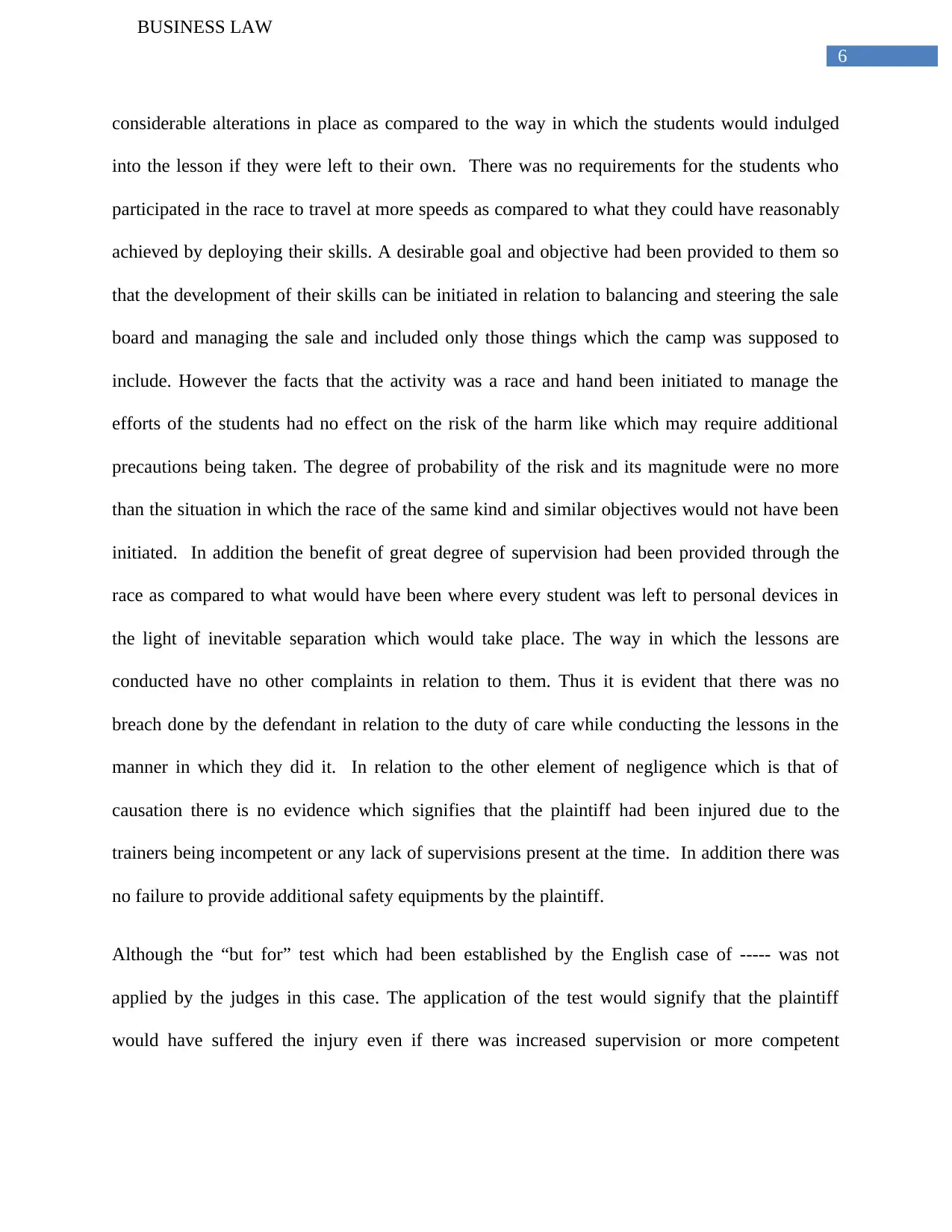
6
BUSINESS LAW
considerable alterations in place as compared to the way in which the students would indulged
into the lesson if they were left to their own. There was no requirements for the students who
participated in the race to travel at more speeds as compared to what they could have reasonably
achieved by deploying their skills. A desirable goal and objective had been provided to them so
that the development of their skills can be initiated in relation to balancing and steering the sale
board and managing the sale and included only those things which the camp was supposed to
include. However the facts that the activity was a race and hand been initiated to manage the
efforts of the students had no effect on the risk of the harm like which may require additional
precautions being taken. The degree of probability of the risk and its magnitude were no more
than the situation in which the race of the same kind and similar objectives would not have been
initiated. In addition the benefit of great degree of supervision had been provided through the
race as compared to what would have been where every student was left to personal devices in
the light of inevitable separation which would take place. The way in which the lessons are
conducted have no other complaints in relation to them. Thus it is evident that there was no
breach done by the defendant in relation to the duty of care while conducting the lessons in the
manner in which they did it. In relation to the other element of negligence which is that of
causation there is no evidence which signifies that the plaintiff had been injured due to the
trainers being incompetent or any lack of supervisions present at the time. In addition there was
no failure to provide additional safety equipments by the plaintiff.
Although the “but for” test which had been established by the English case of ----- was not
applied by the judges in this case. The application of the test would signify that the plaintiff
would have suffered the injury even if there was increased supervision or more competent
BUSINESS LAW
considerable alterations in place as compared to the way in which the students would indulged
into the lesson if they were left to their own. There was no requirements for the students who
participated in the race to travel at more speeds as compared to what they could have reasonably
achieved by deploying their skills. A desirable goal and objective had been provided to them so
that the development of their skills can be initiated in relation to balancing and steering the sale
board and managing the sale and included only those things which the camp was supposed to
include. However the facts that the activity was a race and hand been initiated to manage the
efforts of the students had no effect on the risk of the harm like which may require additional
precautions being taken. The degree of probability of the risk and its magnitude were no more
than the situation in which the race of the same kind and similar objectives would not have been
initiated. In addition the benefit of great degree of supervision had been provided through the
race as compared to what would have been where every student was left to personal devices in
the light of inevitable separation which would take place. The way in which the lessons are
conducted have no other complaints in relation to them. Thus it is evident that there was no
breach done by the defendant in relation to the duty of care while conducting the lessons in the
manner in which they did it. In relation to the other element of negligence which is that of
causation there is no evidence which signifies that the plaintiff had been injured due to the
trainers being incompetent or any lack of supervisions present at the time. In addition there was
no failure to provide additional safety equipments by the plaintiff.
Although the “but for” test which had been established by the English case of ----- was not
applied by the judges in this case. The application of the test would signify that the plaintiff
would have suffered the injury even if there was increased supervision or more competent
Paraphrase This Document
Need a fresh take? Get an instant paraphrase of this document with our AI Paraphraser
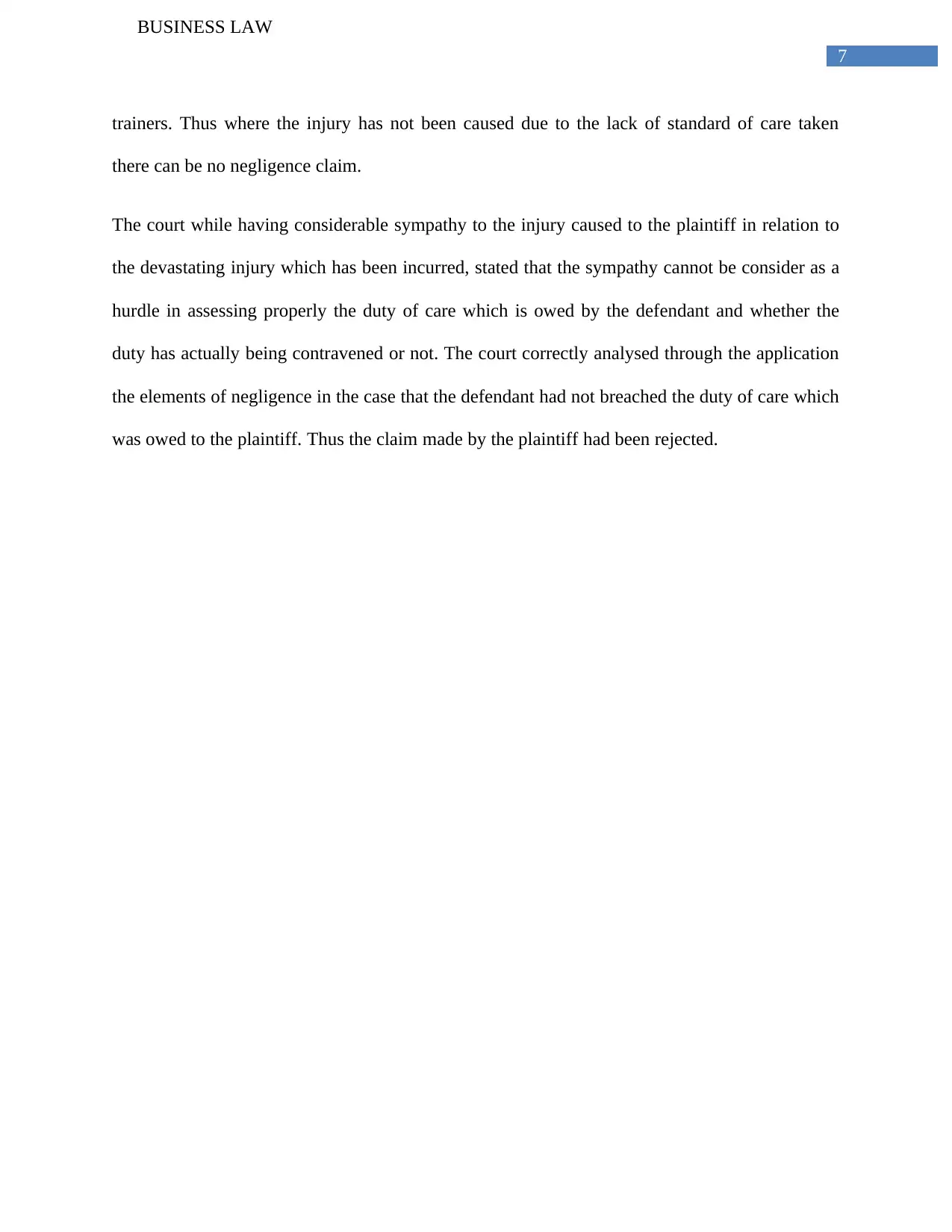
7
BUSINESS LAW
trainers. Thus where the injury has not been caused due to the lack of standard of care taken
there can be no negligence claim.
The court while having considerable sympathy to the injury caused to the plaintiff in relation to
the devastating injury which has been incurred, stated that the sympathy cannot be consider as a
hurdle in assessing properly the duty of care which is owed by the defendant and whether the
duty has actually being contravened or not. The court correctly analysed through the application
the elements of negligence in the case that the defendant had not breached the duty of care which
was owed to the plaintiff. Thus the claim made by the plaintiff had been rejected.
BUSINESS LAW
trainers. Thus where the injury has not been caused due to the lack of standard of care taken
there can be no negligence claim.
The court while having considerable sympathy to the injury caused to the plaintiff in relation to
the devastating injury which has been incurred, stated that the sympathy cannot be consider as a
hurdle in assessing properly the duty of care which is owed by the defendant and whether the
duty has actually being contravened or not. The court correctly analysed through the application
the elements of negligence in the case that the defendant had not breached the duty of care which
was owed to the plaintiff. Thus the claim made by the plaintiff had been rejected.
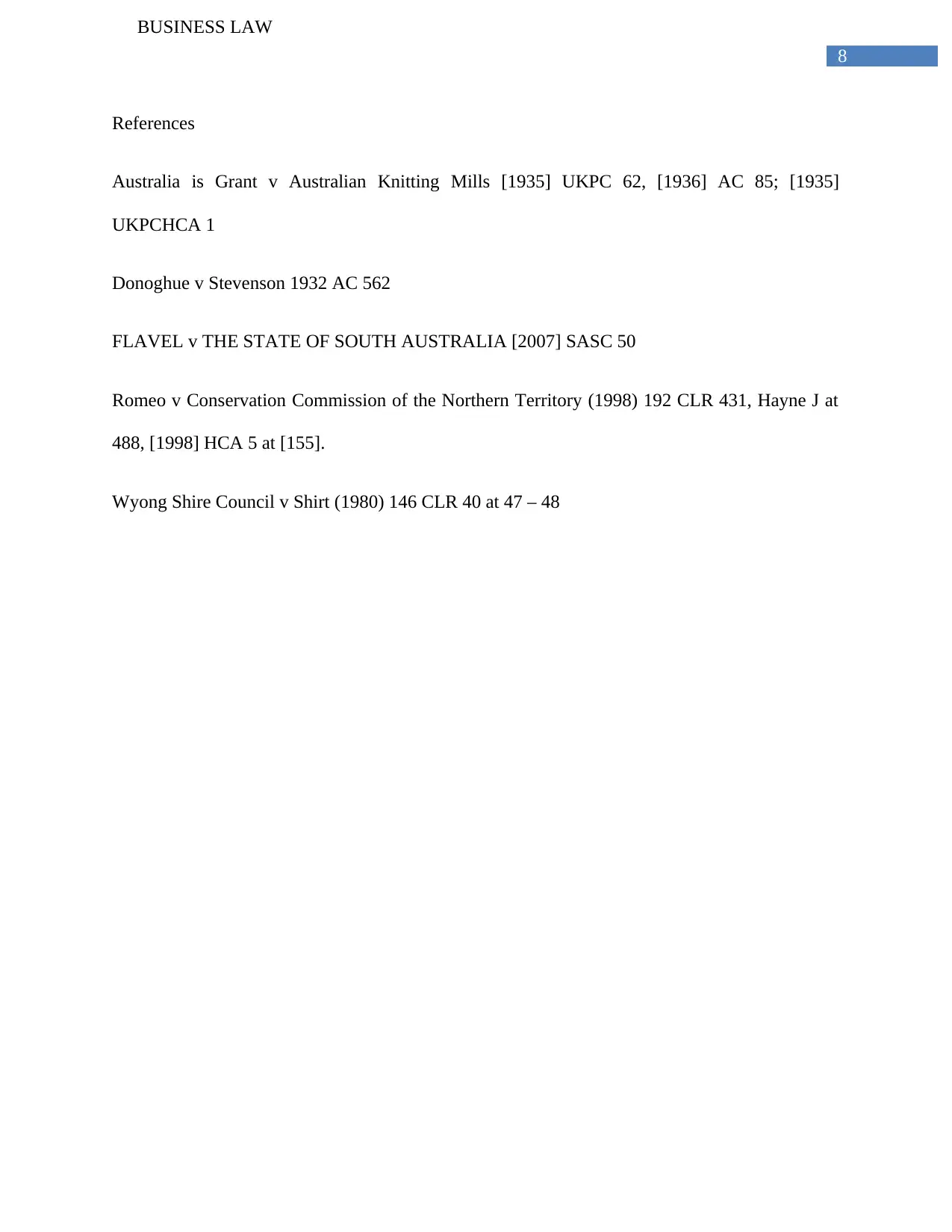
8
BUSINESS LAW
References
Australia is Grant v Australian Knitting Mills [1935] UKPC 62, [1936] AC 85; [1935]
UKPCHCA 1
Donoghue v Stevenson 1932 AC 562
FLAVEL v THE STATE OF SOUTH AUSTRALIA [2007] SASC 50
Romeo v Conservation Commission of the Northern Territory (1998) 192 CLR 431, Hayne J at
488, [1998] HCA 5 at [155].
Wyong Shire Council v Shirt (1980) 146 CLR 40 at 47 – 48
BUSINESS LAW
References
Australia is Grant v Australian Knitting Mills [1935] UKPC 62, [1936] AC 85; [1935]
UKPCHCA 1
Donoghue v Stevenson 1932 AC 562
FLAVEL v THE STATE OF SOUTH AUSTRALIA [2007] SASC 50
Romeo v Conservation Commission of the Northern Territory (1998) 192 CLR 431, Hayne J at
488, [1998] HCA 5 at [155].
Wyong Shire Council v Shirt (1980) 146 CLR 40 at 47 – 48
⊘ This is a preview!⊘
Do you want full access?
Subscribe today to unlock all pages.

Trusted by 1+ million students worldwide
1 out of 9
Related Documents
Your All-in-One AI-Powered Toolkit for Academic Success.
+13062052269
info@desklib.com
Available 24*7 on WhatsApp / Email
![[object Object]](/_next/static/media/star-bottom.7253800d.svg)
Unlock your academic potential
Copyright © 2020–2025 A2Z Services. All Rights Reserved. Developed and managed by ZUCOL.




